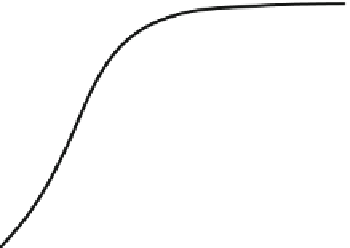Biomedical Engineering Reference
In-Depth Information
Fig. 3.10
For a biomaterial interface problem, the order of the free edge singularity depends upon
the insertion angles and the material orthotropic properties of the adjoining materials
the modulus of the tendon material for stretching in the
x
-direction, and 1,000 times
greater than the modulus of tendon for stretching in the
y
-or
z
- directions. The
anisotropy of the tendon exacerbates the singularity relative even to the Williams
solution: in the William's solution, an isotropic tendon loses the free edge singu-
larity for
y
2
<
~60
, but here even an insertion angle of 15
presents a free edge
singularity. The problem is relieved to some degree by attachment through a
compliant region. If instead tendon attaches to an isotropic material with
E
2
100 times greater than
E
ðxÞ
1
~30
eliminates the free
edge singularity. An interesting feature of this is that a second non-singular region
arises for
y
2
~90
. One could imagine an effective scheme with a compliant
interlayer, in which tendon attaches to a compliant isotropic material at a butt
joint (
y
1
¼ y
2
¼
90
), which attaches to an isotropic bone. This would eliminate
singularities at both interfaces and is loosely related to the scheme that presents at
the healthy tendon-to-bone insertion site (cf. [
4
]).
, an insertion angle of
y
2
<


































































































































































































Search WWH ::

Custom Search